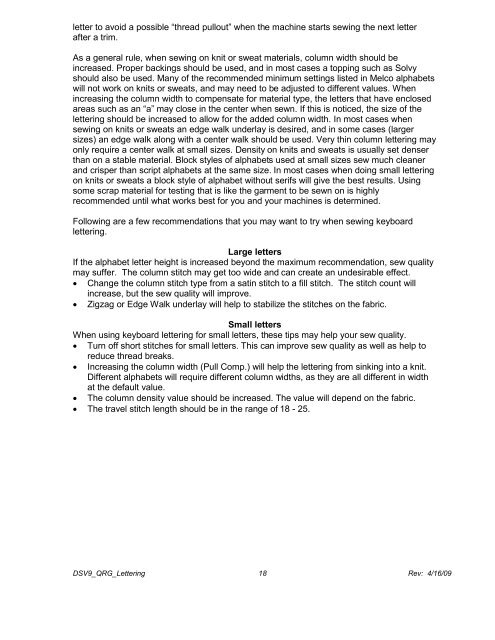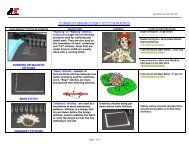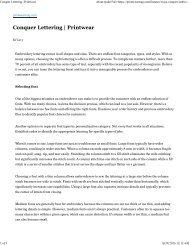Melco Compilation
Create successful ePaper yourself
Turn your PDF publications into a flip-book with our unique Google optimized e-Paper software.
letter to avoid a possible “thread pullout” when the machine starts sewing the next letter<br />
after a trim.<br />
As a general rule, when sewing on knit or sweat materials, column width should be<br />
increased. Proper backings should be used, and in most cases a topping such as Solvy<br />
should also be used. Many of the recommended minimum settings listed in <strong>Melco</strong> alphabets<br />
will not work on knits or sweats, and may need to be adjusted to different values. When<br />
increasing the column width to compensate for material type, the letters that have enclosed<br />
areas such as an “a” may close in the center when sewn. If this is noticed, the size of the<br />
lettering should be increased to allow for the added column width. In most cases when<br />
sewing on knits or sweats an edge walk underlay is desired, and in some cases (larger<br />
sizes) an edge walk along with a center walk should be used. Very thin column lettering may<br />
only require a center walk at small sizes. Density on knits and sweats is usually set denser<br />
than on a stable material. Block styles of alphabets used at small sizes sew much cleaner<br />
and crisper than script alphabets at the same size. In most cases when doing small lettering<br />
on knits or sweats a block style of alphabet without serifs will give the best results. Using<br />
some scrap material for testing that is like the garment to be sewn on is highly<br />
recommended until what works best for you and your machines is determined.<br />
Following are a few recommendations that you may want to try when sewing keyboard<br />
lettering.<br />
Large letters<br />
If the alphabet letter height is increased beyond the maximum recommendation, sew quality<br />
may suffer. The column stitch may get too wide and can create an undesirable effect.<br />
• Change the column stitch type from a satin stitch to a fill stitch. The stitch count will<br />
increase, but the sew quality will improve.<br />
• Zigzag or Edge Walk underlay will help to stabilize the stitches on the fabric.<br />
Small letters<br />
When using keyboard lettering for small letters, these tips may help your sew quality.<br />
• Turn off short stitches for small letters. This can improve sew quality as well as help to<br />
reduce thread breaks.<br />
• Increasing the column width (Pull Comp.) will help the lettering from sinking into a knit.<br />
Different alphabets will require different column widths, as they are all different in width<br />
at the default value.<br />
• The column density value should be increased. The value will depend on the fabric.<br />
• The travel stitch length should be in the range of 18 - 25.<br />
DSV9_QRG_Lettering 18 Rev: 4/16/09




